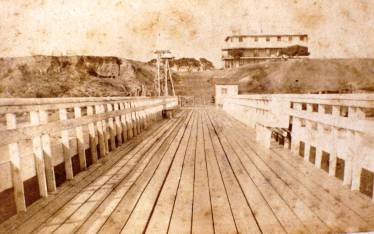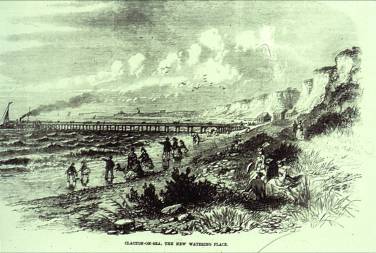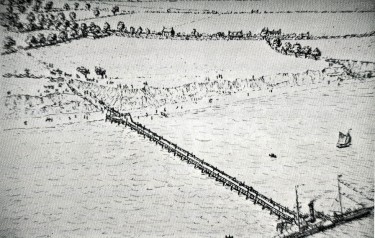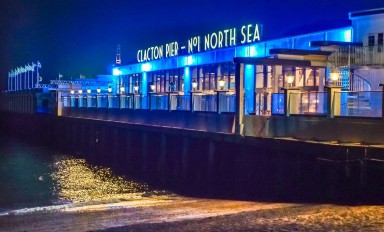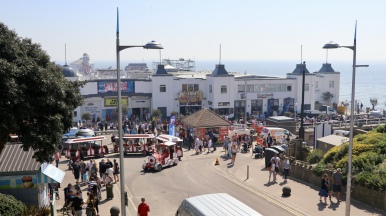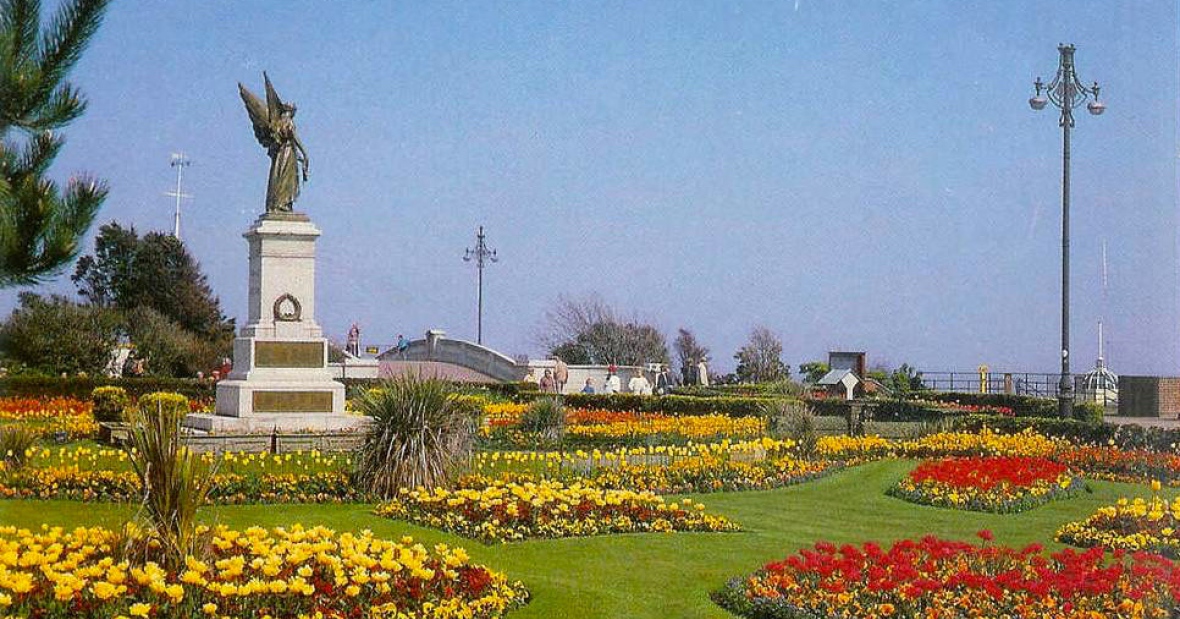
The history of Clacton Pier by Norman Jacobs
It was in July 1866 that the Thorpe and Great Clacton Railway Act was passed by Parliament. This gave local engineer and entrepreneur, Peter Bruff, permission to build a railway spur from Thorpe-le-Soken to Clacton and a pier. The Act also laid down a scale of charges for landing goods at the pier, this included 6d for a barrel of gunpowder, 1d per cubic foot for musical instruments, 2/6d for turtles and £1 for a corpse.
To complete his pier, Bruff looked to outside finance and turned to the Woolwich Steam Packet Company. This company was successfully running steamers on the London to Margate route and was looking for a stopover point about the same distance north of the Thames as Margate was to the south as a way of increasing the trade on their Ipswich route. So they agreed to finance the building of the pier in return for the right of their steamers to call there.
The Pier was completed in 1871 and on the 18 July that year, the first steamship ever to call at Clacton landed at the pier. Its name was SS Queen of the Orwell.
The Pier’s official opening came just over a week later, on 27 July 1871, when the Woolwich Steam Packet Company brought 300 guests on board the SS Albert Edward to take part in the opening celebrations.
The first buildings for visitors to enjoy on the Pier came in the early 1880s when the weatherboard offices, until then used by the Pier superintendent, were converted into the Pier Dining Rooms and then in 1885 to Hot and Cold Sea Water Baths, leased by the Royal Hotel opposite.
During this period, the Pier was lengthened to 1180 feet, making it easier for the paddle steamers to land at any time of the day and to stay longer before having to cast off. These improvements to the Pier saw a significant increase in the number of visitors arriving by paddle steamer, so that between 1880 and 1890 the number of passengers increased from 6,780 to 71,922, while the number of promenades along the pier increased from 31,579 to 224,713.
With the increase in numbers, there was a need to provide entertainments to give the visitors something to do. The first major building on the Pier built solely for entertainment came in 1893 when the Pier Pavilion was erected. Along with the Operetta House, also built in 1893, these were Clacton’s first two theatres.
Clacton continued to grow during the Edwardian period with the Pier playing its part in attracting ever more visitors.
However, with the coming of the First World War in 1914, visitor numbers dropped dramatically and, by the end of the War, with so few visitors, the Pier went bankrupt. It was at this point that Ernest Kingsman stepped into the picture.
In 1919, Kingsman established a holiday camp for ex-soldiers at Lowestoft. His main problem was in providing cheap transport from London. With trains and buses proving too dear, Kingsman turned his attention to paddle steamers.
By investigating this possibility, he learnt that the Coast Development Corporation, the owners of Clacton Pier, was in liquidation. This company also owned the Belle Steamer fleet of paddle steamers as well as the piers at Walton, Southwold and Felixstowe. So he approached the liquidator with a view to re-establishing regular steamer services for taking ex-soldiers to Lowestoft and anyone else who wanted to go to these resorts and took out a year’s lease on the steamer services.
The following year, 1920, Kingsman again met the liquidator with a view to renewing the contract, but this time the liquidator suggested that Mr Kingsman buy the company, all £350,000 worth, and see if he could make a go of it. Kingsman agreed and the deal was settled.
Kingsman then promptly sold everything except Clacton Pier, which he considered had the best potential. Even though it was by this time fairly derelict with just the Pavilion at one end and the two small buildings at the entrance, all in a poor state of repair, Kingsman felt that Clacton was ideally situated to attract visitors from London.
In his first season in charge, Kingsman rigged up a tarpaulin roof over some poles under which visitors danced to a band. It was not too secure and, on rainy nights, the dancers held umbrellas over their heads while they danced. Much of his first year however was spent in making necessary repairs to the structure of the pier.
But its real success as an entertainments centre began in Kingsman’s second season, 1922.
This is how Kingsman described what happened in an interview he gave to Tit Bits magazine in 1934, “At the beginning of my second season…a young man wandered into my office and asked if he could give daily shows for the children….I sent him along to my foreman with instructions for a small open-air dais to be set up, with a carpet in front for the kiddies to sit upon...
“The next afternoon, I heard a hullabaloo and came out of my office to see the cause. At the end of the pier a thousand people were standing, and scores of children sitting on the bit of carpet, and they were shrieking with laughter…It was a riot – and that was the beginning of [Clown] Bertram…”
Kingsman was now certain that the future of the Pier lay in it becoming a large entertainment and amusement complex. He started off by building a proper theatre for Clown Bertram, known as the Children’s Theatre, and then, in 1928, another theatre, the Ocean Theatre. Also in 1928, Kingsman added a large amusement hall in the centre of the Pier called the Crystal Casino
Wanting to go even further, on 24 June 1930, The Kingsman Family put forward a bill to a select committee of the House of Commons to allow them to widen the front of the Pier by
some 90 feet on either side of Pier Gap, which necessitated a compulsory purchase order of land belonging to Clacton Urban District Council. The Council vehemently opposed the bill.
The intention was to demolish the original Blue Lagoon Dance Hall and the office buildings and to build a newer much bigger building, which would include a restaurant and a new Dance Hall. The cost
of the work was estimated at £60,000. The Council objected on the grounds that it would seriously interfere with the amenities of the foreshore.
The House of Commons passed the bill and work started almost immediately on the new Blue Lagoon Dance Hall, which could accommodate 750 couples on the dance floor, and the whole frontage of the Pier took on a completely new and much more welcoming aspect.
Between 1922 and the outbreak of War, the Kingsman Family spent something like a quarter of a million pounds in building new entertainments on the Pier. These included an open air swimming pool, the first to be built on a Pier anywhere in the country. It was a full size Olympic standard 50 metre swimming pool, which was later used by Great Britain to play their international water polo matches in.
1932 also saw the arrival of the Ramblas Concert Party on the Pier when Kingsman set up an open air stage to the left of the Jolly Roger, as the Pier Pavilion had been renamed.
And then, in 1937, perhaps the most iconic image of the Pier during its glory years, the roller coaster, known as the Steel Stella, which became a major attraction in its own right and had people flocking to Clacton Pier.
With all these attractions, entertainments and amusements, Clacton Pier became one of the best known piers in the country and, by the late 1930s, the crowds were flocking in with up to 40,000 people in a single day passing through the turnstiles.
The Pier became affectionately known as no. 1 North Sea and was undoubtedly a major factor in the rise of Clacton to the premier division of British seaside resorts during the 1920s and 30s.
Of course, the coming of the Second World War put a stop to the Pier’s inexorable rise in popularity. During the War, the Pier was badly damaged by a floating mine and then the Ministry of War decided to breach Clacton Pier, blowing a gaping hole in the middle to stop the possibility of the Germans using it as a landing stage.
The result of these actions was that the Crystal Casino and the Children’s Theatre were both destroyed. The Ministry also wanted to dismantle the Steel Stella, but Ernest Kingsman successfully pleaded with them to leave it up.
Sadly, Ernest Kingsman died during the War, with his son, Barney, taking over.
In the immediate Post War years and on into the 1950s, the Pier took up from where it had left off at the end of the 1930s, and once again proved to be a very popular destination for holiday makers.
As well as the pre-War attractions, Barney also added a number of new attractions, including the Cresta Run, a large Helter Skelter, and the Peter Pan Railway.
However, as the 1960s approached, things were beginning to change as British holiday habits also changed. With the ending of post-War austerity and the general rising prosperity of the country, people started to look to going abroad for their holidays where the sunshine could be guaranteed and Clacton Pier began to see a general decline in its number of visitors, slowly at first, but accelerating at an alarming pace through the 1960s and early 70s.
With the decline in the Pier’s fortunes, Barney Kingsman decided it was time to sell the Pier and so, in 1971, it was bought by Michael Goss, bringing to an end the Kingsman Family’s 50 year association with the Pier which had seen it through its most successful period in history.
In an attempt to revive the Pier’s flagging fortunes, Goss’s first action was to close the swimming pool and turn it into a dolphinarium.
The Pier suffered a severe blow in 1974 when the Steel Stella caught fire and was completely destroyed. As if it wasn’t bad enough that the numbers coming to Clacton and the Pier were continuing to fall, it had now lost its major attraction.
In 1978, with audiences continuing to fall, the Ocean Theatre finally closed its doors and was converted into an amusement arcade.
In 1981, a new consortium, headed by Francis McGinty, bought the Pier, which was immediately caught up in a great controversy as three killer whales had been introduced to the Dolphinarium and Greenpeace launched a campaign to “Free the Clacton Three”. Sadly, two of the killer whales died and the Pier came in for much criticism in the national press.
The final Whale, Nemo, was sent to Windsor Safari Park in 1985 and the pool returned to a reduced size swimming pool with a large water chute. However, with numbers continuing to fall, this didn’t last long and the area more or less became derelict apart from a small aquarium on the site.
Undeterred, the new consortium did its best to create new attractions to win back the crowds, these included an ice rink, a circus
and a brand new up-to-date roller coaster called the Whirlwind.
However, it was not to be and most of these attractions did not last long and Clacton itself was in a state of complete depression, particularly following the closure of Butlin’s in 1983.
By the 1990s, visitors to the town were at their lowest level probably for something like 100 years and the Pier was struggling financially and eventually in 1993 the operating company went into receivership which is where it remained for around a year.
In 1994, the Pier was bought by a well-known local family in the amusement and entertainment industry, the Harrisons. The Harrison Family put their expertise in the amusement industry to good effect and put in place a wholesale refurbishment programme as new rides were introduced and others upgraded, while the whole pier was repainte
d and generally refurbished to give a much more welcoming look.
In 2009, the Harrisons sold the Pier to another local family as brothers Billy and Elliot Ball took over and threw themselves into returning the Pier to its old glory days.
Within the first couple of years they had already redeveloped the Cockney Pride Pub, the pub at the front of the Pier, which had long since replaced the Blue Lagoon Dance Hall. This became the Boardwalk Bar and Grill.
New rides were introduced, most significantly a new roller coaster, called Stella’s Revenge, in a nod to the Pier’s history and former iconic landmark. Towards the end of the Pier a new adventure golf facility and a two new eateries were built and a new 10 Pin Bowling Alley Lounge and Bar near the entrance.
The work continued as the Jolly Roger was reopened to house Circus Fantasia and a brand new Go-Kart track covering the largely derelict area left by the closure of the swimming pool was built.
In 2018, a new £4 million extension was built to the left side of the Pier, housing a new adventure playground, a crazy golf course, dodgems and a new cafe.
To demonstrate this return to the Pier’s glory days, one of the new improvements in 2018 was to proudly announce the Pier once again as No. 1 North Sea with a large sign facing outwards on the east side of the Pier.

